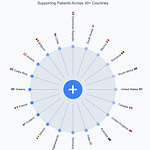Why does an essential vitamin share a name with an addictive drug? Meet nicotine and nicotinic acid, the biochemical cousins that behave like total strangers in your body. This naming similarity has confused students, patients, and even some healthcare professionals for decades.
🗝️ TL;DR:
• Nicotine = plant alkaloid, brain stimulant, addictive
• Nicotinic acid (niacin) = vitamin B₃, vital for energy & DNA repair, non-addictive
• Similar names because chemist Hugo Weidel oxidized nicotine into nicotinic acid in 1873; nutritionists rebranded it “niacin” in 1942 to avoid confusion
How a 19th-Century Lab Experiment Created Decades of Confusion
The story begins in 1828 when German chemists Wilhelm Posselt and Karl Reimann first isolated nicotine from tobacco leaves. They named it after the tobacco plant Nicotiana tabacum, which itself was named after Jean Nicot, the French ambassador to Portugal who popularized tobacco in France in 1560.
Fast forward to 1873, and chemist Hugo Weidel was experimenting with nicotine in his laboratory. Through a process called oxidation, he broke down nicotine and created a new compound.
Following the naming convention of the time, he called it nicotinic acid because it came from nicotine. In 1942 U.S. nutrition authorities adopted niacin (from nicotinic acid vitamin) to prevent the public from thinking bread fortified with the vitamin contained nicotine.
Much like Jekyll and Hyde1, nicotine can be chemically oxidized to nicotinic acid in the lab, but there is no metabolic path between the two in humans.2
Here’s the kicker: Just because nicotinic acid was derived from nicotine doesn’t mean they function similarly in the human body. In fact, they couldn’t be more different.
Structure Determines Function
Understanding why these compounds behave so differently starts with their molecular structures:
Nicotine (C₁₀H₁₄N₂): A complex molecule featuring two connected ring structures—a six-membered pyridine ring attached to a five-membered pyrrolidine ring. This specific arrangement allows nicotine to perfectly fit into nicotinic acetylcholine receptors in your brain.
Nicotinic Acid (C₆H₅NO₂): A form of niacin, the other being nicotinamide (C₆H₆N₂O), with just one six-membered ring and a carboxylic acid group attached. This structure allows it to be easily incorporated into cellular metabolism pathways.
On one hand, you have a key (nicotine) that fits a specific lock (brain receptors). On the other is a building block (nicotinic acid) that gets incorporated into the foundation of a house (cellular metabolism).
The nicotine/nicotinic acid confusion illustrates a broader principle in biochemistry: molecular structure determines function. Small changes in how atoms are arranged can completely alter how a compound behaves in biological systems.
Caffeine energizes you while adenosine makes you sleepy despite being structurally similar. Testosterone and estrogen have vastly different effects despite both being steroid hormones, and different forms of vitamin E have varying biological activities.
How to Remember the Difference
To remember the distinction between these compounds, use these two simple acronyms:
Nicotine ACTS:
Addictive
Cholinergic (acts on acetylcholine receptors)
Tobacco’s active ingredient
Stimulant
Nicotinic acid MENDS:
Mitochondrial function
Essential vitamin (B3)
Necessary for metabolism
DNA repair
Supports cellular health
Nicotine ACTS on your nervous system with immediate effects, while nicotinic acid MENDS and maintains your cellular machinery through slower, fundamental processes.
When Nicotine Enters Your System:
Rapid absorption: Nicotine reaches your brain within seconds of inhalation
Receptor binding: It attaches to nicotinic acetylcholine receptors
Neurotransmitter release: This triggers the release of dopamine, norepinephrine, and other chemicals
Physical effects: Increased heart rate, blood pressure, and alertness
Addiction pathway: The dopamine release creates the potential for dependence
When Nicotinic Acid Enters Your System:
Metabolic conversion: Your body converts it into NAD+ (nicotinamide adenine dinucleotide)
Energy production: NAD+ is crucial for cellular respiration and ATP synthesis
DNA maintenance: It supports DNA repair mechanisms
Cellular health: Helps maintain the integrity of skin, nerves, and digestive system
No addiction potential: It doesn’t interact with reward pathways in the brain
Smoking Cessation vs Essential Nutrition
In medical contexts, nicotine appears in carefully controlled forms. Smoking cessation products like patches, gum, and lozenges use measured doses to help people quit smoking without the harmful effects of tobacco. Scientists are also investigating its potential for treating certain neurological conditions though therapeutic use requires careful dosing to avoid addiction.
Nicotinic acid has an entirely different profile. It’s essential to treat and prevent pellagra, a disease caused by severe niacin deficiency that can lead to dermatitis, diarrhea, dementia, and if left untreated, death.
Historically, nicotinic acid was commonly prescribed for cholesterol management, though newer drugs are now preferred for that purpose. As an essential vitamin for metabolism and cellular function, it’s generally safe, but can cause flushing, gastrointestinal distress, insulin resistance, and liver toxicity at pharmacological doses (≥1–2 g/day).
Key Takeaway
The next time you see nicotine and nicotinic acid mentioned together, remember that one ACTS on your brain with powerful, addictive effects, while the other MENDS your cells through essential metabolic processes.
Understanding this distinction can help you make more informed decisions about your health and have more productive conversations with healthcare providers.
Honestly, the Jekyll and Hyde metaphor works a lot better for the epigenetic transformation that enables some species of grasshoppers to transform into stark raving mad locusts, but cut me some slack.
While tobacco plants can convert nicotinic acid into nicotine as part of their natural alkaloid synthesis, these compounds function as completely separate substances in the human body.









